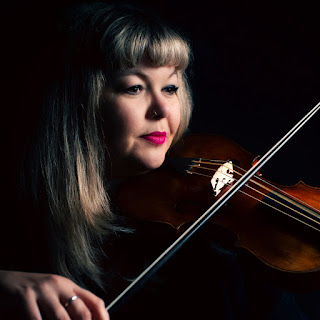 |
| Holly Harman |
Ground: Nicola Matteis, Heinrich Biber, Turlough O’Carolan/James Oswald, Marco Uccellini, Alice Zawadzki, Sid Goldsmith; Holly Harman, Carina Cosgrave, Oliver John Ruthven, Kristiina Watt, Sid Goldsmith; Stone Nest
Reviewed 30 April 2025
Launching her album, Ground, violinist Holly Harman & friends entrance with their mix of Baroque and folk, virtuosity and directness.
Violinist Holly Harman says of her new album, Ground on Penny Fiddle Records that the name might be seen “…as a reference to ground bass, those beguiling, repeating bass lines, present in so much of the music I love, whether it’s baroque or folk music. It’s also a reference to feeling, at times, ground down by life and industry. This has made me question head-on the expectations I feel the industry has of me, and the expectations I have of myself…. This album is my response to exploring these ideas, and consequently starting to feel a bit more grounded in myself.”
Harman launched the album with a pair of concerts and we caught the second, at Stone Nest on 30 April 2025. For the recital, Harman was joined by the instrumentalists from the recording, Carina Cosgrave (violone), Oliver John Ruthven (harpsichord), Kristiina Watt (theorbo) and Sid Goldsmith (cittern) for a repertoire that moved from Baroque violin to folk and contemporary, with music by Matteis, Biber, and Uccellini alongside Harman and Goldsmith’s arrangement of a tune by Turlough O’Carolan as collected by James Oswald and some of Goldsmith’s own folk melodies and a new piece by Alice Zawadzki.
Harman began unaccompanied with the Scots reel Balfour Road, a catchy and engaging way to draw us in. Then she followed this with the Passagio Rotto & Fantasia by the Italian composer Nicola Matteis (c1650-1713) who travelled to London in the 1670s and had success with his published music and this piece comes from a collection published in 1676. Harman explained that it was designed to sound improvised, and is began with rather rhapsodic passagework before becoming more strenuous including plenty of double stopping.
There was more double stopping with the dramatic gesture that began Heinrich Biber’s Sonata No. 3 (from 1681). Biber was born in Bohemia but settled in Salzburg where he was notable for his violin playing and compositions for the instrument, though he did not limit himself to this, writing significant polychoral works for Salzburg Cathedral too. For Sonata No. 3, Harman was joined by a continuo group of Carina Cosgrave (violone), Kristiina Watt (theorbo) and Oliver John Ruthven (harpsichord).
The sonata was a real tour de force, with Biber presenting the player with a whole range of challenges from the vigorously passagework at the beginning, positively rhapsodic moments with some lyrically thoughtful, then what sounded like divisions on a ground before ending with a rather free section with some really amazing passagework, where the music was driving forward in an amazing manner. And like the Matteis, there was an improvisatory freedom to it.
We returned to the folk idiom with a piece that reached across the centuries. The Fairy Queen was a tune written by the blind Irish harpist Turlough O’Carolan (1670-1738) which was then published in polite form by James Oswald (1710-1769) the Scottish composer who published popular selections of folk melodies. And we heard the piece in a version by Harman and folk-singer Sid Goldsmith, who joined her on cittern, which mixed up O’Carolan’s original and Oswald’s version creating a distinct aura of lyric melancholy with a sound world that was most appealing.
Marco Uccellini (1610?-1680) is an Italian composer about whom little is known, though he worked in Assisi and Modena. Much of his work has not survived and his is known for his instrumental sonatas. Harman with continuo from Cosgrave, Watt and Ruthven gave us a sequence of three from a publication from 1645, the intriguingly named Sonata Seconda a violino solo detta La Luciminia Contenta, Sonata Quarta a violino solo detta La Hortensia Virtuosa, and Sonata ouer Toccata Quinta a violin solo detta La Laura Rilucente. The first began rhapsodically, but there was a strong rhetorical feel to the violin part, and whilst it was elaborate, there was an intriguing directness to it, ending with plenty of vigour. The second sonata was more lyrical, but with fast moments, whilst the third began as an elegant dance but ending in some astonishing passagework. I have no idea who Laura Rilucente was but she was clearly quite a girl!
Get Thee To The Trees was a commission from vocalist, violinist, songwriter and composer Alice Zawadzki, which was written for violin and bass (Carina Cosgrave playing from the balcony). The bass provided a discreet drone that grounded the work, which Harman described as being about the noise and chaos of everyday live. Slow violin phrases with notes being bent, were interrupted by short angular motifs, somewhat like angry birdsong, with a central section where the meditative melodic music was interrupted by the angry birdsong figures, leading to something of a reel, yet we ended with the angry birdsong. It was an intriguing and rather compelling piece, with a tantalising underlying narrative.
This led rather naturally into Biber’s Sonata Representiva for violin and continuo when between and opening Allegro and a final Allemande, there were a series of movements evoking a nightingale, cuckoo, frog, hen and cockerel, quail and cat. The opening was vigorous, upfront and rather bravura then the nightingale was an excuse for some virtuoso moments in the solo violin. Each section was engaging in the way Biber mixed the animal call with virtuosity. I was not completely convinced by his strangely dissonant frog, whilst the miaow of the cat was mixed into more vigorous playing. The penultimate movement was described as Musketeers March with Cosgrove putting paper on the violone’s fingerboard to create a drum-like effect. All great fun, yet with vivid virtuosity too.
We ended back in folk territory with a pair of pieces from Harman and Goldsmith. The first, Air Like Wine, an original piece by Goldsmith with a title taken from a Ewan McColl song, a slow, melancholy piece that gradually accumulated violin decoration. The second, Half a shandy featured some busy fiddling, fun indeed.
There was an encored, a song from Goldsmith with Harman playing, their own arrangement of the tradition song The Parting Glass.
Harman is a really engaging performer, able to move from easy virtuosity to folk directness and make the connections between the styles and eras of the music. Altogether a lovely recital, and the disc is definitely work exploring. Ground is available from Harman’s Penny Fiddle Records whose previous releases include Carina Drury’s Irlandiani [see my review].
The blog is free, but I’d be delighted if you were to show your appreciation by buying me a coffee.
Elsewhere on this blog
- Something of a revelation: forgotten songs by Robert Gund & William Grosz from Christian Immler & Helmut Deutsch – record review
- A genre finding its way: Maurice Greene’s Jephtha reveals different English oratorio before Handel consolidate the form – record review
- More than novelty value: at Conway Hall, the Zoffany Ensemble explores substantial 19th century French works for nine instruments – concert review
- Creating a fun day out as well as broadening the mind: Jack Bazalgette on his first Cheltenham Music Festival as artistic director – interview
- From RVW’s Sancta Civitas & Bliss’ The Beatitudes to Reich’s The Desert Music & Birtwistle’s Earth Dances, plus 19 premieres: the BBC Proms 2025
- Fierce virtuosity & sheer delight: oboist Olivier Stankiewicz, soprano Lucy Crowe, violinist Maria Włoszczowska & friends in a captivating evening of Bach, Zelenka, Handel, Vivaldi – concert review
- Dramatic engagement: Francesco Corti directs Bach’s St John Passion with the English Concert at Wigmore Hall on Good Friday – concert review
- Searching for possibilities: composer Noah Max on his four string quartets recently recorded by the Tippett Quartet on Toccata Classics – interview
- Youthful impulse and power: Mozart’s Requiem from National Youth Choir, Sinfonia Smith Square and Nicholas Chalmers – concert review
- Looking at these modern classics anew: Britten’s Canticles at the Barbican with James Way, Natalie Burch & friends – concert review
- Home







